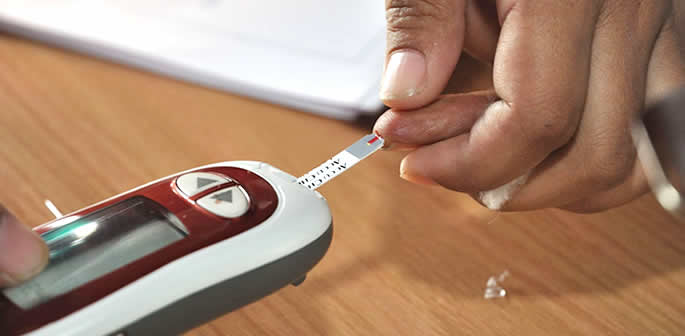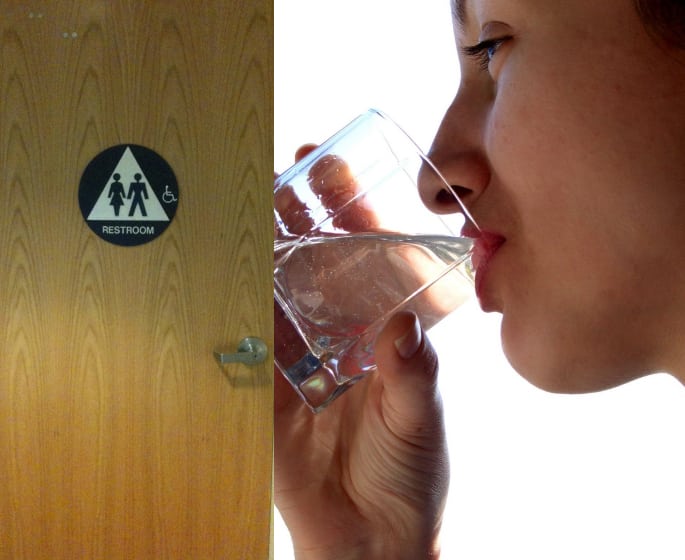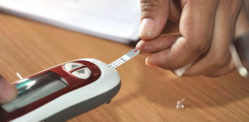Type 2 diabetes is more common in overweight people
Diabetes is a serious health condition which affects over 3.7 million people in the UK. People more at risk from developing it include people who are of South Asian origin.
Insulin is needed by the body to convert sugar in the blood into useable energy. Diabetes results from the condition when the blood sugar level is too high and is classified into two types.
Type 1 diabetes is caused by the body not producing insulin.
Type 2 diabetes is caused by the body not responding well to insulin.
Around 90% of cases are caused by Type 2 diabetes.
With South Asians being at a higher risk, medical findings say that the age at which you are more at risk as a South Asian person is 25.
It is down to the different ways of storing fat, as well as diet and lifestyle which put people from South Asian communities at a higher risk.
The symptoms of Type 2 diabetes are not obvious and would be revealed during a medical check-up. This is because the symptoms develop more slowly than Type 1 diabetes.
Due to this, it’s estimated that there are almost one million undiagnosed people living in the UK and more than 36 million in India.
There are signs of diabetes which should not be ignored and are quite common. These include unexplained weight loss, feeling tired and going to the toilet more often.
We look at seven signs of diabetes you cannot ignore.
Weight Change
A change in weight is the most common sign of diabetes especially weight loss which is a symptom of Type 1 diabetes.
If you begin losing weight and you do not know why then it could be a sign.
This is down to your body not being able to produce insulin.
The easiest way to get energy is by eating. If the body cannot get energy from the food eaten, it will begin to burn muscle and fat for energy instead.
As a result, you may start to lose weight even though you have not changed how you eat.
Type 2 diabetes is more common in overweight people because fat can build up around the organs.
Being overweight is an issue for many with South Asian roots. Fatty diets, foods high in sugar and a lack of being active can lead to obesity.
This can lead to insulin resistance as insulin cannot pass. Therefore it increases the chance of having high blood glucose.
The risk can be reduced by maintaining a healthier weight by opting for a more healthier desi diet.
Reducing white sugar in your diet will also help immensely.
Thirst and Frequent Urination
Urinating more often, especially at night, is a common symptom.
The average person usually has to urinate between four and seven times within a 24 hour period but people with Type 2 diabetes may go more.
This is because the body takes in glucose as it passes through the kidneys.
With diabetes, it increases your blood sugar and as a result, it cannot bring it all back in.
This causes the body to create more urine, which takes fluids, leading you to become very thirsty, another linked symptom.
The term for it is polydipsia.
Diabetes.co.uk states:
“Increased thirst in people with diabetes can sometimes be, but certainly not always, an indication of higher than normal blood glucose levels.”
It is recommended to drink six and eight glasses per day.
However, feeling thirsty all the time is a possible sign of diabetes.
Tiredness
Feeling tired is a symptom often associated with the condition.
This could be the result of either high or low sugar levels.
Blood sugar levels go high when there is not enough insulin or it is not working effectively.
It means the sugar in the blood cannot get into the cells and they do not receive the energy they need, therefore fatigue occurs.
Dr Joel Zonszein, director of Clinical Diabetes Centre at the University Hospital of the Albert Einstein College of Medicine in New York says that high blood sugar is not the only cause.
He said: “Some people get dehydrated because their blood sugars are so high and this leads to increased urination.”
“The fatigue, in part, comes from the dehydration.”
Wounds Healing Slower
One symptom which can potentially become worse if diabetes is left undiagnosed is the time it takes for wounds to heal.
Wounds heal slower than usual and progress quickly, so it is something to look out for.
High blood sugar will prevent the immune system from functioning properly and increases inflammation in the body’s cells.
Although cuts and wounds can appear anywhere on the body, the feet are one of the most common places of injury for a diabetic person.
Over time, high blood sugar can cause nerve damage which makes it more difficult for the body to heal cuts.
Because wounds progress quickly, a small cut on the foot can quickly turn into a foot ulcer.
If left untreated, foot ulcers can become serious. Twenty-five per cent of diabetes caused foot ulcers which do not heal requires amputation.
It is vital that regular self-checks are made on any cuts. If it takes longer than usual to heal, then contact your doctor.
Itchiness
Itchy skin is another symptom which cannot be ignored, especially as it links to urinating more often.
Because the body uses fluids to pee, there is less moisture which can leave skin feeling dry which can make you feel itchy.
High blood sugar levels over a long period of time is another cause of itchy skin. A common place is the feet, legs or ankles.
Blood sugar levels can cause nerve damage which leads to persistent itching.
It can make a person feel that they need to constantly scratch, but that only leads to the person needing to scratch even more.
Itching can become severe but can be relieved through treatment such as a number of moisturisers. It may be completely removed if the main cause is treated.
So if you experience itchy skin more than usual, do not ignore it.
Infections
Another symptom to look out for are a number of infections.
This is due to high blood sugar levels which weakens a person’s immune system.
Because the immune system is weakened, it provides the ideal conditions for bacteria to grow, causing infection.
Infections which commonly occur are foot infections, yeast infections and urinary tract infections.
They usually affect the feet, mouth and genital area.
A yeast infection is a symptom which can go unnoticed when it comes to linking it with diabetes.
Dr. Sally Norton said: “A high blood sugar can make you prone to infection, so itching down below may be a symptom you hadn’t thought of.”
It is a symptom to be aware of because diabetic people are more affected.
They experience worse outcomes than someone without the disease.
Diabetic people with an infection face longer hospitalisation and recovery times as a result of their weakened immune system.
Blurry Vision
Blurry vision is a less common but a more serious symptom of diabetes.
It is an issue which is caused because of high blood sugar levels. Blurry vision develops quickly as a result.
The issue can affect one or both eyes.
Blurry vision happens because high blood sugar causes the lens of the eye to swell, changing a person’s ability to see.
This results in the loss of sharpness of vision and the inability to see fine details.
Blurry vision is less serious when there are low levels of blood sugar, it usually returns to normal when sugar levels increase.
If blurriness does not go away when sugar levels are almost normal, you could have retinopathy.
This is when high sugar levels damage blood vessels in the retina, which can cause blindness.
So it is a symptom to watch out for.
These symptoms are all signs of potentially having diabetes.
Some are more common than others. Some of the symptoms are more serious which can lead to long-term issues if not treated.
If you experience one or more of these symptoms frequently, do not ignore them. Contact your doctor to get checked.
You can also buy diabetes test kits over the counter at reputable pharmacists.
For further information, you can visit the UK’s Diabetes support website here.



































































